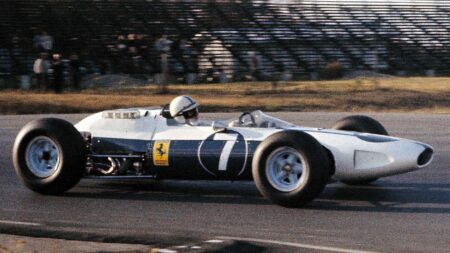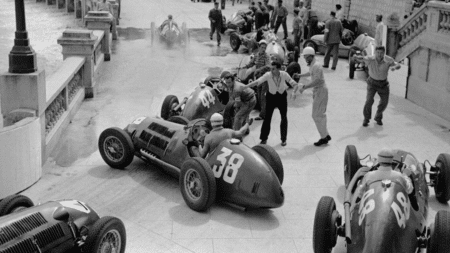A week from Sunday I’ll be trackside at Long Beach as I have been for all 40 previous street races in Southern California. From 1976-83 Long Beach was a Formula 1 Grand Prix but it enjoyed its healthiest days as a CART race pulling in more than 200,000 people over the weekend and 90,000 on race day from the late ‘80s through the turn of the century. Long Beach continues these days with an IndyCar race on Sunday and a United SportsCar race on Saturday but the crowds are much smaller, less than half what they once were.

For me, Long Beach always brings back fond memories of Formula 5000. The first Long Beach race in September of 1975 was a round of America’s F5000 championship which I had the pleasure of covering in those days. The race was famously won by Brian Redman at the wheel of a Jim Hall/Carl Haas Lola T332 after each of Mario Andretti, Al Unser and Tony Brise came to grief while leading the race.

Photo: Jutta Fausel
F5000 cars raced in America from 1968-76 and the series was at its height when it raced in Long Beach in ’75. More than 40 cars built by seven different constructors showed up at Long Beach and similarly large fields and big crowds gathered at Laguna Seca and Riverside two and three weeks later. Redman was the man to beat, winning three F5000 championships in a row from 1974-76 with Haas/Hall Racing’s Lola T332s defeating, among others, the Vel’s Parnelli Jones Lolas driven by Indy stars Mario Andretti and Al Unser.
“Everybody talks about the great days of the Can-Am but they never talk about Formula 5000,” Redman remarks. “Very often, people talk about the Can-Am and they often talk to me about my sports car career. But I always say, ‘Actually, I’m rather more proud of my Formula 5000 career.’ Often, a curious look comes on their faces and they ask, ‘What’s Formula 5000?’.”
At Long Beach in 1975 Redman scored a classic win, nursing home a sick car after early leaders Andretti, Unser and Brise dropped out. Forty-two cars practiced and 39 cars started the two qualifying heats. F1 star Jody Scheckter drove a second Hogan Lola beside Carl Hogan’s regular driver David Hobbs, US F5000 champion in 1971. Tom Pryce was in a second Shadow beside Jackie Oliver, Chris Amon was driving a Talon, and up-and-coming young Brit Brise made his American debut in a Sid Taylor/Teddy Yip Lola.
“It was a huge field, and very talented too,” Redman says. “We were lucky at Long Beach, of course, because in practice the car snapped sideways when I landed after I went over that big jump in the road before turn one. I told Jim Hall about it and he said, ‘What do you think?’ I said, ‘It’s probably the differential.’ He said, ‘I hate to strip it the night before the race.’.”

The diff was dutifully replaced but it broke again in the race. “About 10 or 12 laps into the race I was sitting in fourth place behind Mario and Al and Tony Brise, and it broke again,” Redman says. “So I had to back-off, not just over the jump but also going up the hill to the last turn onto the pit straight which was very rough. Going through there I was on part throttle and over the jump I wasn’t jumping. I was keeping the car down and being gentle with it. And undoubtedly due to that, we won the race.”
Redman says those years were the highlight of his long and amazingly varied career. “It was a fantastic time,” Brian grins. “The cars were great and there’s no question that our crew – Franz Weis, Troy Rogers, Davey Evans and Tony Connor – were incredible. Today, you would have 15 people doing the work that they did in those days.
“They absolutely were a great team,” Redman continues. “They worked night and day, and of course, Franz Weis was a brilliant test driver. I could have gone to any race and not practiced. All I had to do was take a bit of rear wing off, or stiffen the rear roll bar because he liked a bit more push [understeer] than I did. Otherwise, I could have started anywhere without any practice because the car was exactly right for every track we went to.
“Of course, Franz built the engines as well. I think the engines were a bit on the conservative side. I don’t know, but I think Mario had a bit more power at times. But the engines were great too, and I think in the four years we had one engine failure and one suspension failure at Road America in practice. That was it. I don’t think we had a gearbox failure or anything else.”

Photo: Jutta Fausel
David Hobbs is convinced that in his prime Redman was as good as any racing driver he’s ever seen. “I really have to say those two Formula 5000 years when Brian was up against Mario and Al and the VPJ team, and me at Hogan, I think those years got glossed over by most of the press,” Hobbs comments. “It was hardly taken any notice of in England. But to me, those years demonstrated that Brian absolutely was an outstanding driver.
“I know he did fantastic things in sports cars but he was always considered the second driver to Ickx or Seppi Siffert. But if you talk to people like John Horsman they’ll tell you that Brian was the quickest and the most consistent of all of those guys in those Porsches and Ferraris.
“I think the fact that he blew Mario off in F5000 – and I think those VPJ Lolas were as good as the Haas/Hall cars – I think that showed to me what an incredible driver Brian was. On the track, he was ferocious. Remember that only a few years later Mario went on to win the world championship.
“If Brian had applied himself to the political side of racing and to his choice of career as well as he applied himself to his driving he would have been a world champion. But he could never quite decide if racing was what he wanted to do.

Photo: Jutta Fausel
“I think Brian showed his real skill. Obviously he did that in the World Sportscar Championship in Porsches and Ferraris, but he really showed how good he was in those years in F5000.”
Andretti was very quick in F5000 but he couldn’t match Redman and the Haas/Hall team on reliability and consistency. In those days Redman and Andretti were able to hustle their Lola T332-Chevys around serious road courses like Watkins Glen and Mosport as fast, or even a shade faster, than the Formula 1 cars of the time.
“I thoroughly enjoyed Formula 5000,” Andretti comments. “They were great cars to drive. At some places I was quicker than a Formula 1 car. At Riverside where I had a lot of time and testing in the 5000 car, I never could match the F5000 time with our F1 car. Those F5000 cars were good-looking and there were a lot of different builders. There was the Shadow and All American Racers built a number of different Eagles, and there was the Talon and some others too, which made it pretty interesting.
“Whenever I finished, most of the time I won. I loved that car. I think we really had it nailed. Anytime you’re in a series where you can win almost any race you enter, you always remember that fondly. And that’s the way I feel about Formula 5000.”

Photo: Racemaker/Marc Sproule
But early in the winter of 1976-77 the SCCA decided to toss F5000 on the trash heap of history and replace it with the ‘new era’ Can-Am – F5000 with closed-wheel bodywork. The SCCA and most promoters believed the American public wasn’t interested in open-wheel cars. They though that Can-Am-type closed wheel cars were the only way to go and to this day the decision raises David Hobbs’ hackles.
“The powers-that-be at the SCCA could not get the Can-Am out of their brain,” Hobbs remarks. “They couldn’t figure out that the Can-Am was a one-off and that to have a completely open formula meant it couldn’t last, and also that you couldn’t bring it back. Just putting bodywork on a F5000 car wasn’t going to bring the Can-Am back.
“But the promoters agreed with the SCCA guys,” Hobbs adds. “People like Les Griebling at Mid-Ohio said people won’t pay to watch open-wheel racing in America. Then of course, just three years later CART started going to road courses and soon they had the biggest crowds they’d ever had at places like Mid-Ohio, Elkhart Lake and Laguna Seca.”
The ‘new era’ Can-Am got off to a bad start. In practice for the first race at St Jovite in the spring of 1977, Redman’s Haas/Hall F5000-based Lola Can-Am car flipped after Brian asked Jim Hall to trim some downforce from his front wings. It was the third seriously bad accident of Redman’s career, leaving him with a broken neck. Mind you, it was far from the end of Brian’s career as he came back to win both the Daytona 24 Hours and IMSA’s GTP championship in 1981. But by then F5000 was a fast-fading memory.

Photo: Racemaker/Sproule
“It was almost the series that should have been,” Andretti comments. “You had a small fuel tank and there was no refueling. You had two heats and a final and for some reason it was not really considered the top level and the events were not taken that seriously. That’s the way I saw it. They wanted to try to make it as popular as the Can-Am had been, but something didn’t catch on.
“I loved the cars and the idea of Formula 5000. The cars were fast, they were neat to drive and they were good road racing cars. But unfortunately, there was something lacking in that formula to make it an absolute main event. It was not totally appreciated for what it was. Some of the stigma of Formula A remained, like it was SCCA racing. They really didn’t help it grow or become properly professional.”
David Hobbs reflects on F5000’s lost potential. “In those last few years we had every top American driving in Formula 5000, except Foyt,” Hobbs says. “We had Mario, the Unsers, Mike Mosley, Johncock and Rutherford. All American Racers were there too with Bobby Unser. You also had all those Aussie drivers like Kevin Bartlett, Warwick Brown, Max Stewart and Frank Matich, who gave Jack Brabham and Jimmy Clark a run in their day. At one time that series was a real who’s who of Formula 5000 racing around the world, but they blew the whole thing.
“Twenty years later,” Hobbs adds, “they tried to turn the clock back when Tony George started the IRL and went to production-based engines. Well, they had the right formula once. CART should have been the Formula 5000 car. They had it right there and with development they would have developed like every other car. They would have been quick as hell today.”











